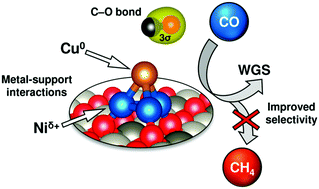DFT insights into structural effects of Ni–Cu/CeO2 catalysts for CO selective reaction towards water–gas shift†
Abstract
The water–gas shift (WGS) reaction is a key step in hydrogen production, particularly to meet the high-purity H2 requirement of PEM fuel cells. The catalysts currently employed in large-scale WGS plants require a two-step process to overcome thermodynamic and kinetic limitations. Ni–Cu/CeO2 solids are promising catalysts for the one-step process required for small-scale applications, as the addition of Cu hinders undesired methanation reactions occurring on Ni/CeO2. In this work, we performed calculations on Ni4−xCux/CeO2(111) systems to evaluate the influence of cluster conformation on the selectivity towards water–gas shift. The structure and miscibility of CeO2-supported Ni4−xCux clusters were investigated and compared with those of gas-phase clusters to understand the effect of metal–support interactions. The adsorption of CO onto apical Ni and Cu atoms of Ni4−xCux/CeO2(111) systems was studied, and changes in the C–O bond strength were confirmed at the electronic level by investigating shifts in the 3σ and 1π orbitals. The selectivity towards WGS was evaluated using Brønsted–Evans–Polanyi relations for the C–O activation energy. Overall, a strengthening of the C–O bond and an increase in CO dissociation energy were verified on Cu-containing clusters, explaining the improvement in selectivity of Ni4−xCux/CeO2(111) systems.



 Please wait while we load your content...
Please wait while we load your content...